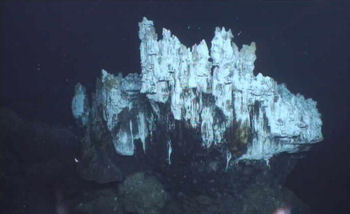Chemistry
We also don't know the full effect that deep-sea vents have on the chemistry of the oceans. Some of the elements in vent fluids, such as iron, are nutrients for marine life in surface waters. But how far do they disperse from deep-sea vents? And what happens to the organic carbon created at vents - how long does it persist, and how far does it go?
The hot fluids gushing from the vents rise in a column above the seafloor, mixing with the cooler seawater as they go. At a few hundred meters above the seabed, they start to spread out. Chemical reactions between the vent fluids and seawater continue in these vent plumes, as they start to spin into vortices because of the Earth's rotation, and get blown by deep ocean currents.

One of the key tasks during the expedition will tracking these vent plumes to pinpoint the deep-sea vents on the seafloor, so that we know where to send our undersea vehicles. As part of our research project, we will also be mapping the plumes from the vents and studying the chemical reactions taking place inside them, to improve our understanding of the effects vent fluids have on the surrounding ocean.
Page 1: Pool cleaners of the world's oceans
Page 2: Deepest and hottest?
Page 3: Getting the big picture
Want to dive deeper?
Visit Venture Ocean to find out more about deep-sea vents
Explore the different types of deep-sea vents found so far on the ocean floor
Read more about the 'Lost City' vent field
Science
Find out more about the Cayman Trough, undersea volcanoes, deep-sea vents,
and the inhabitants of the abyss.
What are we investigating?


